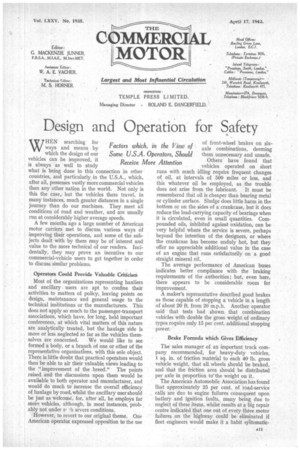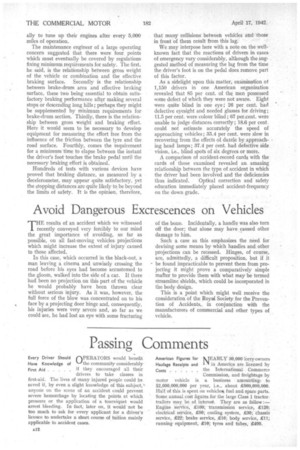Design and Operation for Safety
Page 13

Page 14

If you've noticed an error in this article please click here to report it so we can fix it.
WHEN searching for ways and means by which the design of our vehicles can be improved, it is always as well to study what is being done in this connection in other countries, and particularly in the U.S.A., which, after all, possesses vastly more commercial vehicles than any other nation in the world. Not only is this the case,, but the vehicles there travel, in many instances, much greater distances in a single journey than do our machines. They meet all conditions of road and weather, and are usually run at considerably higher average speeds.
A few months ago a large number of American motor carriers met to discuss various ways of improving their operations, and some of the subjects dealt with by them may be of' interest and value to the more technical of our readers. Incidentally, they may prove an incentive to our commercial-vehicle users to get together in order to discuss similar problems.
Operators Could Provide Valuable Criticism Most of the organizations representing hauliers and ancillary users are apt to confine their activities to matters of policy, leaving points on design, maintenance and general usage to the technical institutions or the manufacturers. This does not apply so much to the passenger-transport associations, which have, for long, held important conferences, at which vital matters of this nature are analytically treated, but the haulage side is more or less neglected so far as the vehicles them selves are concerned. We would like to see formed a body, or a branch of one or other of the representative organizations, with this sole object. There is little doubt that practical operators would then be able to air their valuable views leading to the if improvement of the breed." The points raised and the discussions upon them would be available to both operator and manufacturer, and would do much to increase the overall efficiency of haulage by road, whilst the ancillary user should be just as welcome, for, after all, he employs far more vehicles, although, in most instances, probably not under sl -h severe conditions.
However, to revert to our original theme. One American operator expressed opposition to the use of front-wheel brakes on sixaxle combinations, deeming them unnecessary and unsafe.
Others have found that vehicles operated on short runs with much idling require frequent changes of oil, at intervals of 300 miles or less, and this whatever oil be employed, as the trouble does not arise from the lubricant. It must be remembered that oil is cheaper than bearing metal or cylinder surface. Sludge does little harm in the bottom or on the sides of a crankcase, but it does reduce the load-carrying capacity of bearings when it is circulated, even in small quantities. Compounded oils, inhibited against oxidation, can be very helpful where the service is severe, perhaps beyond the intention of the designers, or where the crankcase has become unduly hot, but they offer no appreciable additional value in the case of an engine that runs satisfactorily on a good straight mineral oil.
The average performance of American buses indicates better compliance with the braking requirements of the authorities ; but, even here, there appears to be considerable room for improvement.
A maker's representative described good brakes as those capable of stopping a vehicle in a length of about 20 ft. from 20 m.p.h. Another operator said that tests had shown that combination vehicles with double the gross weight of ordinary types require only 15 per cent, additional stopping power.
Brake Formula which Gives Efficiency The sales manager of an important truck company recommended, for heavy-duty vehicles, 1 sq. in. of friction material to each 40 lb. gross vehicle weight, that all. wheels should be braked, and that the friction area should be distributed per axle in proportion tolhe weight on it.
The American Automobile Association has found that approximately 25 per cent, of road-service calls are due to engine failures consequent upon battery and ignition faults, many being due to neglect of these items, whilst results at a big repair centre indicated that one out of every three motor failures on the highway could be eliminated if fleet engineers would make it a habit syitematic ally to tune up their engines after every 5,000 miles of operation.
The maintenance engineer of a large operating concern suggested that there were four points which must eventually be covered by regulations fixing minimum requirements for safety. The first, he said, is the relationship between gross weight of the vehicle or combination and the effective braking surface. Secondly is the relationship between brake-drum area and effective braking surface, these two being essential to obtain satisfactory braking performance aftcr making several stops or descending long hills ; perhaps they might be supplemented by minimum requirements for brake-drum section. Thirdly, there is the relationship between gross weight and braking effort. Here it would seem to be necessary to develop equipment for measuring the effort free from the influence of the friction between the tyre and the road surface. Fourthly, comes the requirement for a minimum time to elapse between the instant the driver's foot touches the brake pedal until the necessary braking effort is obtained.
Hundreds of tests with various devices have proved that braking distance, as measured by a clecelerometer, may appear quite satisfactory, yet the stopping distances are quite likely to, be beyond the limits of safety. It is the opinion, therefore, that many collisions betweeti vehicles and those in front of them result from this lag.
We may interpose here with a note on the wellknown fact that the reactions of drivers in cases of emergency vary considerably, although the Suggested method of measuring the lag from the time the driver's foot is on the pedal does remove part of this factor.
As a sidelight upon this matter, examination of 1,150 drivers in one American organization revealed that 85 per cent. of the men possessed some defect of which they were not aware. Eight were Quite blind in one eye ; 26 per cent. had defective eyesight and needed glasses for .driving; 11.5 per cent. were colour blind ; 67 per cent. were unable to judge distances 'correctly; 18.6 per cent. could not estimate accurately the speed of approaching vehicles ; 35.4 per cent, were slow in recovering from the effects of dazzle by approaching head lamps; 37.4 per cent. had defective side vision, i.e., blind spots of six degrees or more.
A comparison of accident-record cards with the cards of those examined revealed an amazing relationship between the type of accident in which the driver had been involved and the deficiencies thus indicated. Optical correction and safety education immediately placed accident-frequency on the down grade.




















































